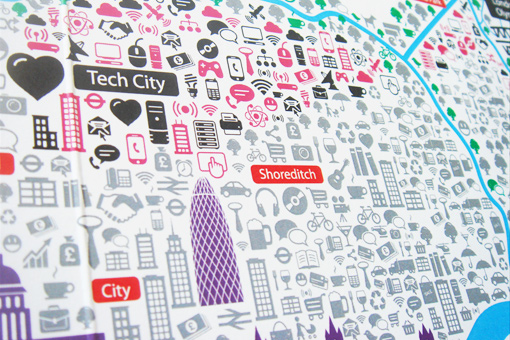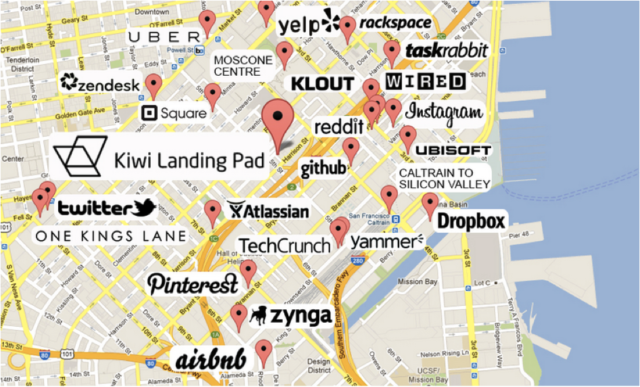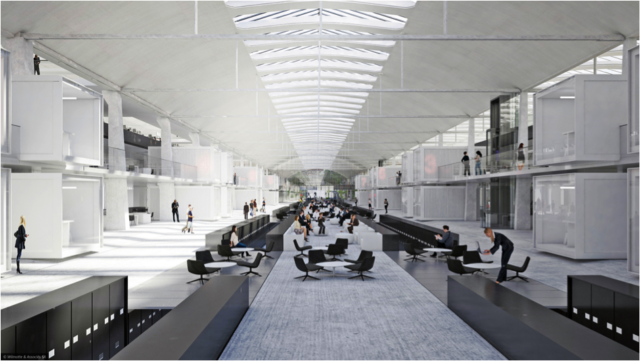A Tale of Tech Cities
décembre 16, 2014 — Uncategorized
From San Francisco to Seattle to New York, tech companies are increasingly choosing to base themselves in city centers rather than in Silicon Valley. Understanding the factors pulling tech inside city walls not only suggests a new paradigm for the industry, but also has major implications for urban economic development and policy.
Over the past decade, 40% of the most valuable and public tech firms stemmed from outside of Silicon Valley. This figure, published in a recent study in the Financial Times by Skype’s co-founder Niklas Zennström, questions the South Bay’s long unrivalled technological leadership. From the 1960s onwards, suburban technological parks had been the hotbed of high-tech industries. However, things are changing, and today tech seems to be spreading outside of its traditional boundaries.

From London to Tel Aviv, Singapore to New York, Berlin, São Paulo and San Francisco, tech is going urban. And it’s viral.
Traditionally, tech activities were concentrated into few high-tech clusters, such as Route 128 or Silicon Valley. However, innovation and reduced entry barriers within the computer industry have enabled many countries and urban areas to catch-up. As a result, tech entrepreneurs are increasingly establishing their companies in entirely urban environments. The flourishing of so-called “tech districts” in the world’s cities (such as London’s Tech City or New York’s Silicon Alley) attest to this changing nature of tech geography.
But what exactly is driving this rise of the “start-up city”, as the urban theorist Richard Florida puts it? Why is tech moving downtown? And why does it matter?
Seeking Talent, Economic Diversity and Quality of Life
As innovation is a major driver of economic development, understanding the causes of the urbanization of tech is crucial to foster growth at the local level. Even if unraveling all the factors pulling tech downtown isn’t easy, talking with entrepreneurs across various US cities made me realize that the urbanization of tech really comes down to three key factors.
First, talent. Human capital appears be the pivotal driver of this urban shift. Young graduates and experienced professionals tend to concentrate in cities, turning these spaces into a pool of talent for tech start-ups.
But there’s something more than just talent. “It’s not only about the tech people, but also about the culture of mentorship and support”, explained Jack Dorsey, co-founder of Twitter, when I spoke to him earlier this year. “When I came to San Francisco in 1999, the tech community in the city was very open to people sharing what worked, their mistakes, failures and successes”. This resourcefulness of the local tech community – composed of entrepreneurs, but also professors and venture capitalists – helped Mr. Dorsey learn a great deal before developing Twitter. These start-up ecosystems are crucial for tech entrepreneurs and provide them with valuable support, advice and resources.

Economic diversity also seems to play an important role in the urbanizing geography of tech. The economic variety of urban environments fosters the cross-fertilization between tech and other local industrial sectors: scholars dub this “regional branching”. In that context, it is no surprise that finance tech is booming in London or that New York is the new hotbed of digital advertising.
Quality of life also appears to be a strong factor for tech founders seeking to establish their new businesses. “Founding our start-up in Seattle was a personal choice”, confessed Joey Kotkins, co-founder of Inside Social, a social marketing app based in Seattle. “We love it here – the energy is great and the weather is much nicer than what people generally think. The quality of life is very high, and life relatively inexpensive”.
Throughout my interviews, I was struck by the importance that tech founders attach to urban amenities. Yet restaurants, cafés, bars, leisure facilities and cultural venues favor informal meetings and boost creativity. The urban vibe therefore doesn’t only match tech-savvy individuals’ idiosyncratic preferences, but also enables encounters, the exchange of ideas and spontaneous collaboration. In other words, urban quality of life reinforces the weaving of local tech communities.

Tech Cities: Implications for Public Policy
All together, these findings offer various lessons for policymakers. If attracting talent is essential, supporting the burgeoning and growth of start-up ecosystems should also be made a priority. Building on economic diversity and breaking barriers between tech and other sectors would also favor the cross-fertilization of ideas. Encouraging regional branching would indeed spur the growth of local tech scenes and reinforce urban competitive advantages, thus supporting innovation and economic development. Also, ensuring good urban quality of life and offering vibrant cultural agendas should also help cities attract tech entrepreneurs. Ultimately, these recommendations can take many different forms: business plan contests, start-up challenges, networking events, incubators, fiscal incentives for tech entrepreneurs… The list is long.
Finally, a good communications strategy is critical. Signaling and promoting local start-ups and tech-supporting initiatives is a great plan – see how Microsoft made Seattle, or how Google Fiber is heating up the tech scene in Kansas City. Indeed, success stories contribute to the building of a trusted environment, encouraging investors and entrepreneurs alike to undertake business locally.
Of course, there is no one-size-fits-all solution, and no miracle remedy either. But a proper understanding of local conditions, and a good mix of well-designed policies and city branding is a great way to start building a strong urban tech ecosystem.